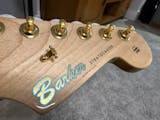Many of you have requested this. So here we go.
• Nitrocellulose lacquer is susceptible to ‘blooming’ if sprayed in humid conditions. This can be easily fixed by lightly sanding the finish with 600 grit and spraying a fresh coat in drier conditions.
• Lacquer and sealer should be stored and sprayed at room temperature.
• Proper preparation of the workpiece is critical to achieving a high quality finish. • Do not expose the workpiece to dramatic temperature fluctuations.
• ‘Keying’ is the process of very lightly sanding a finish with 600 grit abrasive paper, and is done between coats. Its purpose is to improve adhesion between the existing coat and the new coat about to be applied. It should not remove much material - it is only a very light swipe over with abrasive.
• Any preparation or ‘keying’ sanding should be done dry, and using abrasive paper no finer than 600 grit.
• Wet sanding should only be done at the polishing stage, and even then keep moisture to a minimum and avoid drill holes. Allowing water to get into the wood and finish can lead to cracking and discolouration.
• The guitar body should be sprayed flat to avoid runs and drips.
• The body should be supported by screwing a length of wood into the neck pocket, then clamping this to the edge of a table. The body is then suspended in the air without touching any of the sprayed surfaces, it can be turned easily for spraying both the front and back, and the edges are accessible. Safety Precautions
• Nitrocellulose lacquer should only be sprayed in a well ventilated area.
• Always wear a suitably filtered face mask when spraying.
• Always wear the gloves provided when spraying - contact with skin can cause irritation and dryness.
• Read full safety precautions on the back of the can before use. Aerosol Spray Technique
• Do not warm the cans above room temperature before use (warm lacquer flash-drys which can lead to latent structural problems in the finish).
• Always shake aerosols for two minutes before use.
• Always depress the spray nozzle fully when spraying.
• Start and finish each stroke off the workpiece.
• Release the nozzle at the end of each stroke.
• Overlap each stroke by 50%
• Do not apply more than 3 coats of sealer or topcoat in one day. To spray a coat:
• Spray one side, moving steadily back and forth across the workpiece.
• Spray the edges. Be sure to get in the contours, inside the cutaways etc.
• Turn the body and spray the back.
• Leave this to dry for 4 hours, key lightly with 600 grit abrasive paper, then repeat for the next coat. A Preparation
• Open pored woods (such as swamp ash and mahogany) should be grain filled before finishing. Both our waterborne and thixotropic grain fillers are suitable under nitrocellulose lacquer.
• Once grain filled, or if using a closed pored wood such as alder or maple, the wood should be sanded to 320 grit.
• Do not sand bare wood using paper finer than 320 grit, as this can cause an uneven, undulating surface.
• The aim is to achieve a surface which is flat and smooth. Any roughness will not be filled by the sealer coats to come, so needs to be sorted at this stage. B Priming
• The sealer primer is a high build white sealer which forms the bulk of the finish. It binds to the wood and gives a uniform layer which can be sanded to an ultra fine 600 grit, and which gives the top coats something to adhere to.
• We recommend spraying a minimum of three coats. Leave these to dry overnight, then flat sand with 600 grit abrasive paper, dry. If the wood is sufficiently sealed then this sanding will give a smooth surface which is uniform in both feel and appearance. It should be level, without dimples, without bare wood showing, and with an even sheen. It is safest to think of this as your final finish, as any imperfections will not be covered up by the clear top coat. If the surface is not like this, spray additional coats of sealer, leave these to dry overnight, then sand again with 600 grit. Repeat until the wood is sealed.
• Use the whole can of metallic paint to spray the body.
• Aerosol technique is as described above.
• Spraying schedule is as per the primer.
• Do not key or perform any sanding between coats.
• This is vital - The final coats should be very light, sprayed from a distance and from various angles. This will improve the metallic effect of the paint.
• Before applying the clear top coat do not sand and avoid handling the metallic painted surface. Metallic finishes must have a top coat applied over them. The same spray technique and schedule should be used for the clear top coat as for the sealer coats. We recommend a minimum of three coats, although it is difficult to give a precise number as it depends on how heavily you spray each coat. For a Stratocaster® size body you will need to use about 1½ aerosols of lacquer.
Polishing
1. Wet sand the finish, in straight lines, using the 600 grit abrasive paper until smooth.
2. Repeat this process with the 800, 1000, 1200, 1500 and finally the 2000 grit papers in order.
3. Ensure the body is dry and free from any sanding residue.
4. Dab a small amount of the RF3 polishing compound onto one of the microfibre cloths. Using the same motion as used for the wet sanding, apply the RF3 to the body.
5. Using a fresh cloth, repeat this process with RF5.
6. Using a fresh cloth, repeat this process with RF7.
• The clear top coat should be allowed to dry for two weeks before polishing.
• It is imperative that no stages of this polishing process are skipped. Each stage will remove the scratch marks introduced by the stage before.
• Wet sanding and polishing with the liquid compounds should be done in straight lines, not using a swirl or circular motion.
• When wet sanding only a very small amount of water should be used, only enough to lubricate the paper. Do not flood the surface or allow water to get into any open drill holes in the wood.
• The first stage using 600 grit is the most important of all, and great care should be taken here to take out any imperfections or unevenness in the finish. Each subsequent stage has less cutting power, so will not be able to deal with any issues not dealt with by the 600 grit.
• All three microfibre cloths supplied are identical aside from the colour. We supply three cloths so one can be used for each liquid polishing compound. Do not contaminate the cloths with other compounds.
• Each stage of the polishing process should gradually increase the shine and glossiness of the body. By the end of the RF7 stage you should have a high gloss glassy finish to your body. Taddah!
Oh, and one more thing - ALWAYS TEST COLOUR ON AN INCONSPICUOUS AREA FOR SUITABILITY Sorry to shout but it's really important.



